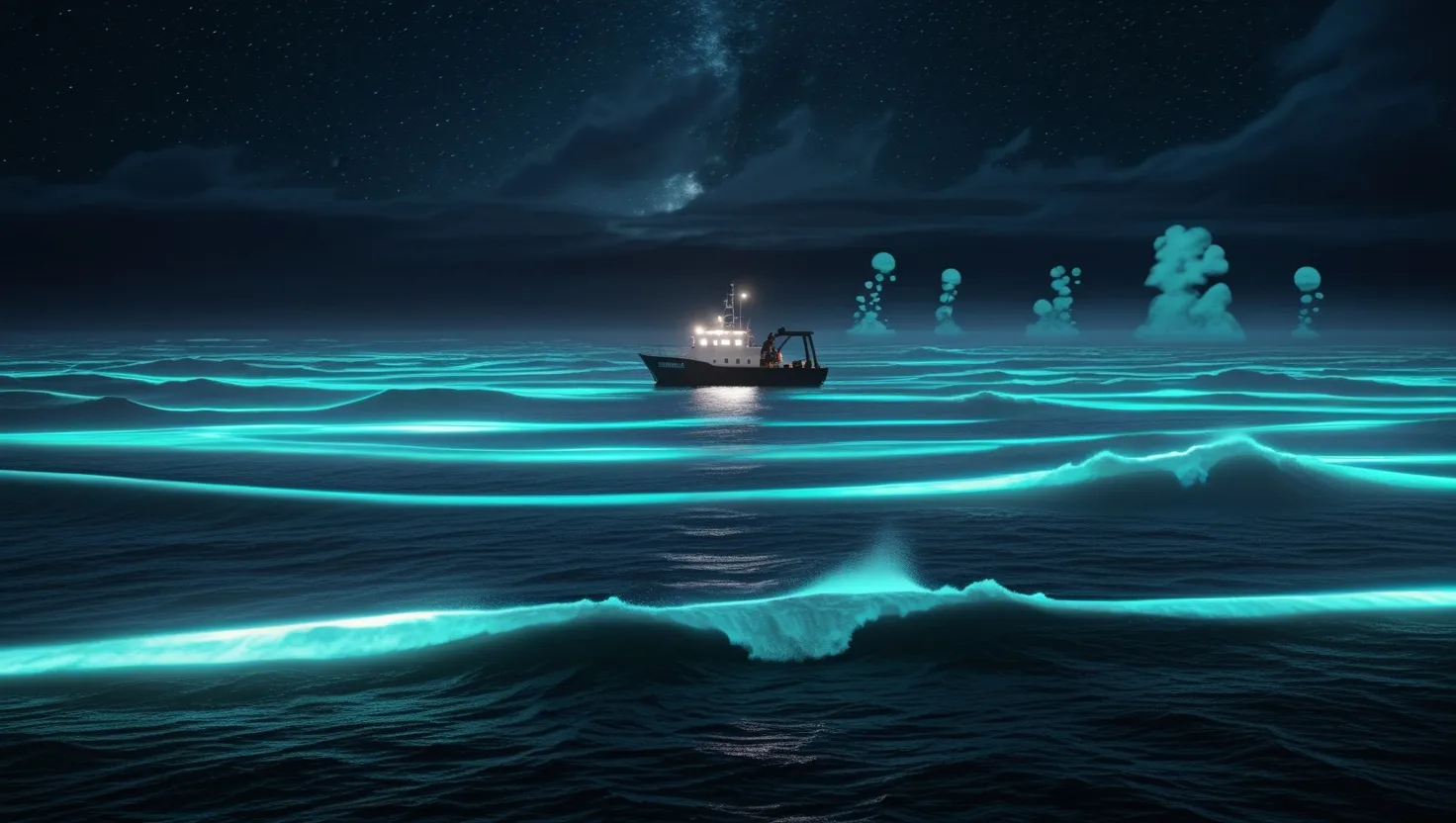The ocean covers more than two-thirds of our planet, yet most of it remains veiled in mystery. Every time we believe we’ve figured out a piece of the puzzle, something unexpected surfaces—or glows—reminding us just how much we don’t know. I find these strange marine phenomena both exhilarating and humbling. Let’s walk together through eight of the most mysterious ocean events that continue to puzzle the world’s sharpest scientific minds.
Have you ever stared at a satellite image and noticed a massive patch of ocean glowing eerily at night? If so, you’ve probably seen a milky sea. These are not your average bioluminescent waves. Imagine an area as big as a small country shining a soft, milky white glow for nights on end. Sailors have described the experience as sailing through clouds on the water. What’s truly odd is the way trillions of tiny bacteria seem to coordinate their glowing, lighting an expanse so vast it’s visible from space. Current ecological models can’t quite explain how these microbes synchronize over such distances. Why do these bacteria suddenly decide to shine together, sometimes forming well-defined edges that look almost artificial from above? Is there a hidden chemical signal, a microbial internet pulsing through the dark ocean, or does something else entirely drive this giant nocturnal display?
“The sea, once it casts its spell, holds one in its net of wonder forever.” — Jacques Yves Cousteau
Now, if we plunge below the surface, another giant stirs. Oceanic internal waves are invisible from above but stretch for hundreds of kilometers and can stand taller than city skyscrapers. These slow-moving titans ripple deep within the sea, passing like silent freight trains between water layers of slightly different densities. Why do they form such perfect, gigantic patterns, and how do they move so much energy without breaking apart? Even with supercomputers, researchers struggle to model their behavior. Sometimes, these waves create underwater turbulence so intense that they redistribute nutrients and heat across massive distances. But their full role in shaping the ocean’s climate engine is still a topic of heated debate. What would we find if we could somehow ride one of these waves from its birth to its dissipation in the abyss?
The deep ocean isn’t always calm. Sometimes, powerful abyssal storms burst forth, accelerating bottom currents to 10 times their usual speed, and keeping this up for weeks. What sets them off? There’s no clear surface storm, earthquake, or sudden event to trigger them. Yet, these surges are strong enough to shuffle massive dunes of sediment and influence the global conveyor belt of ocean circulation. Could hidden seismic activity, changes in the earth’s core, or even unknown deep-sea chemistry play a role? We’re not sure, but every time instruments catch one of these events, models of ocean circulation get a little more complicated.
“Man cannot discover new oceans unless he has the courage to lose sight of the shore.” — André Gide
Drifting to the Arctic and Antarctic fringes, I’m fascinated by the growing plumes known as methane chimneys. Imagine columns of gas, sometimes hundreds of meters wide, bubbling up from the seafloor like a vast underwater volcano. These plumes are formed by methane escaping from hydrate reserves—icy compounds buried under immense pressure. What alarms scientists is the increasing frequency and size of these chimneys, hinting that something is destabilizing the seafloor. If released suddenly, this methane could accelerate climate change far beyond current predictions. Are we seeing the effects of warming oceans, shifting tectonic plates, or is something else at play deep in the sediments?
On occasion, I’ve wondered if the earth itself is speaking a new language beneath the waves. Ocean quakes are not simple underwater versions of earthquakes; they create distinctive seismic signatures that zigzag across the seabed in unexpected patterns. Sometimes, these signals don’t match any known geological structure, and the energy seems to move along hidden channels or barriers. What are we missing in our sonar maps? Is there a vast network of unexplored canyons, or possibly even ancient tectonic features rediscovered by modern instruments? The differences between ocean and land quakes might point to unseen layers of the earth’s crust or to interactions with the overlying water column that merit closer scrutiny.
“The sea is everything. It covers seven tenths of the terrestrial globe. Its breath is pure and healthy. It is an immense desert, where man is never lonely, for he feels life stirring on all sides.” — Jules Verne
One of the strangest discoveries in recent years comes not from what we see, but from what we find living miles beneath the surface. Seafloor microbiomes have turned up life forms that feed on radioactive elements, effectively “eating” uranium, thorium, or cesium—and, incredibly, transforming these materials into useful compounds. Even more astonishing, some microbes produce enzymes capable of breaking down plastics and other pollutants that usually persist in the environment for centuries. How did these organisms acquire such abilities? Is the seabed a crucible of biochemical innovation, fueled by millions of years of isolation and extreme conditions? And what might they teach us about cleaning up human-made waste on land?
Our ears, too, are being opened to ocean secrets. Hidden layers of water, known as sound channels, carry acoustic signals over thousands of kilometers with almost no loss. Whales, dolphins, and even some fish seem to use these natural corridors to communicate and navigate across entire ocean basins. Scientists are only beginning to map the full extent of these channels and their surprising quirks. For example, why do some signals suddenly increase in clarity at certain depths or times? Are there unknown species or cryptic signals being sent across these corridors? If so, what do we stand to learn about the “language” of the oceans?
Sometimes, what’s most mysterious is how rapidly things can change. Flash thermoclines—sudden and dramatic shifts in temperature boundaries between water layers—can occur in minutes, not days. That’s like having winter and summer swap places while you’re out for a swim. These abrupt temperature changes can disrupt plankton blooms, confuse fish migrations, and even trigger strange weather patterns that ripple thousands of kilometers away. What mechanisms drive such rapid changes? Is it the interplay of submarine currents, underwater volcanoes, or perhaps something we’ve not yet detected?
Here’s a question: if these phenomena are so prominent—visible from space, powerful enough to rewrite climate equations, and shaping entire ecosystems—why are they still not fully understood?
In many cases, it comes down to access. The ocean is hostile to exploration. Crushing pressures, bone-chilling cold, and constant darkness ensure that even the most advanced robots and submersibles struggle to capture real-time data. Funding usually follows human priorities, and the deep sea is easy to overlook compared to terrestrial projects. But the ocean’s mysteries don’t wait for our convenience; they keep rewriting the rulebook. Each new discovery hints at deeper interconnections and feedback loops, from microbial metabolism to global climate shifts.
Some might say the answer is simply better technology or more diligent monitoring. But I think part of the challenge is how we ask the questions. Are we open to solutions that may blur boundaries between biology, chemistry, physics, and geology? Can we imagine ecosystems where life orchestrates energy flows on scales once thought impossible? Are we missing clues because we’re searching for patterns too familiar to our terrestrial minds?
“Earth’s last great living wilderness is the sea. Beneath its surface, mysteries abound, waiting only for the patience—and the curiosity—to discover them.” — Sylvia Earle
The ocean teaches humility—not just as a physical force, but as a puzzle whose rules and players often don’t match our expectations. Each of these eight phenomena stands as a quiet defiance to human certainty, a living challenge to our models, equations, and beliefs. They are more than curiosities; they suggest the sea is not merely a passive environment, but an active participant in shaping our planet’s fate.
So, do we have the courage to listen to the ocean’s questions, and not just race to answer them? Are we ready to accept that the clues we seek may come from unexpected places—a glowing patch, a sudden current, or a microbe munching on radioactive rocks? The next chapter in ocean science is being written right now—by instruments drifting through the dark, by satellites scanning glowing seas, and by anyone willing to peer beyond the familiar and sit with the weird.
Every time I see a new paper describing some strange event—a storm with no wind, a current that goes nowhere, a light without obvious cause—I am reminded that mystery is not an obstacle, but an invitation. Will you accept it?






